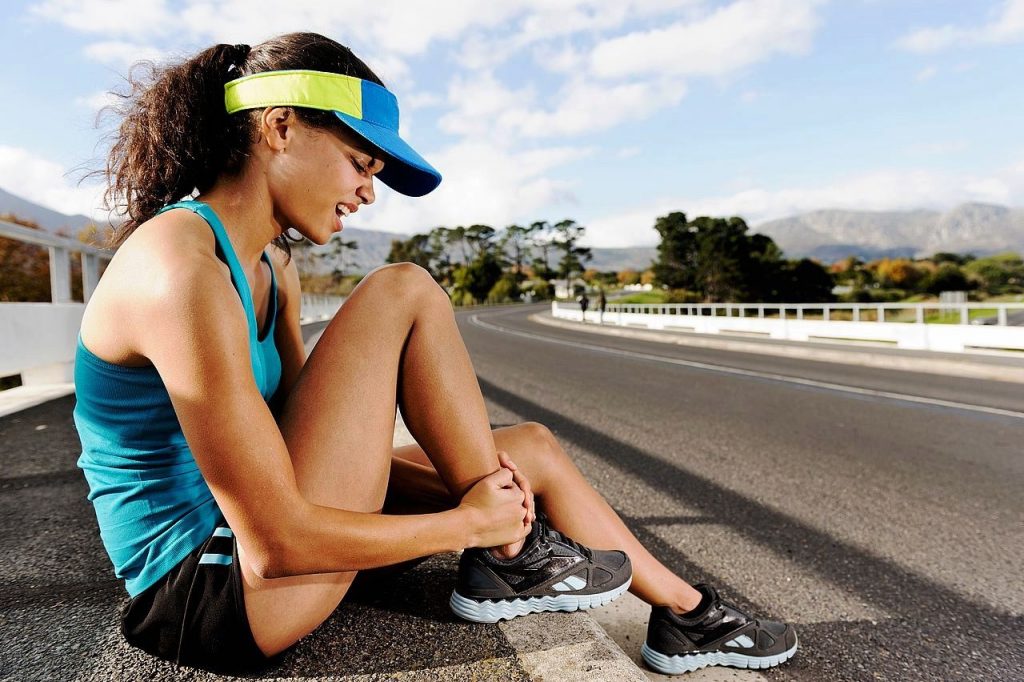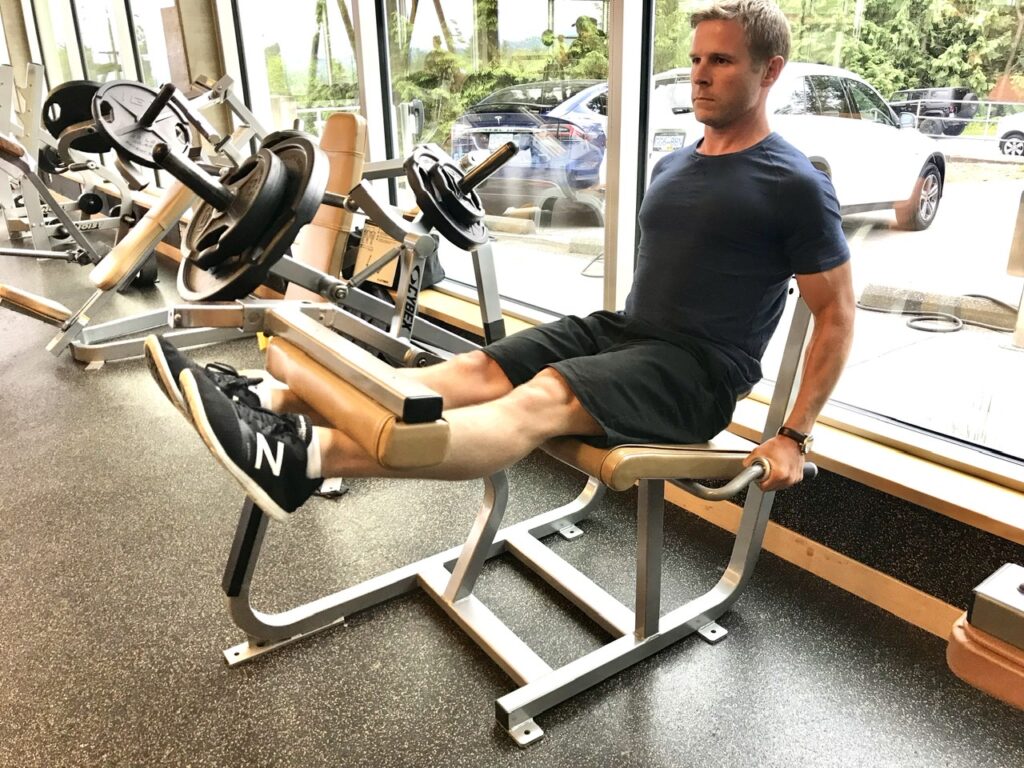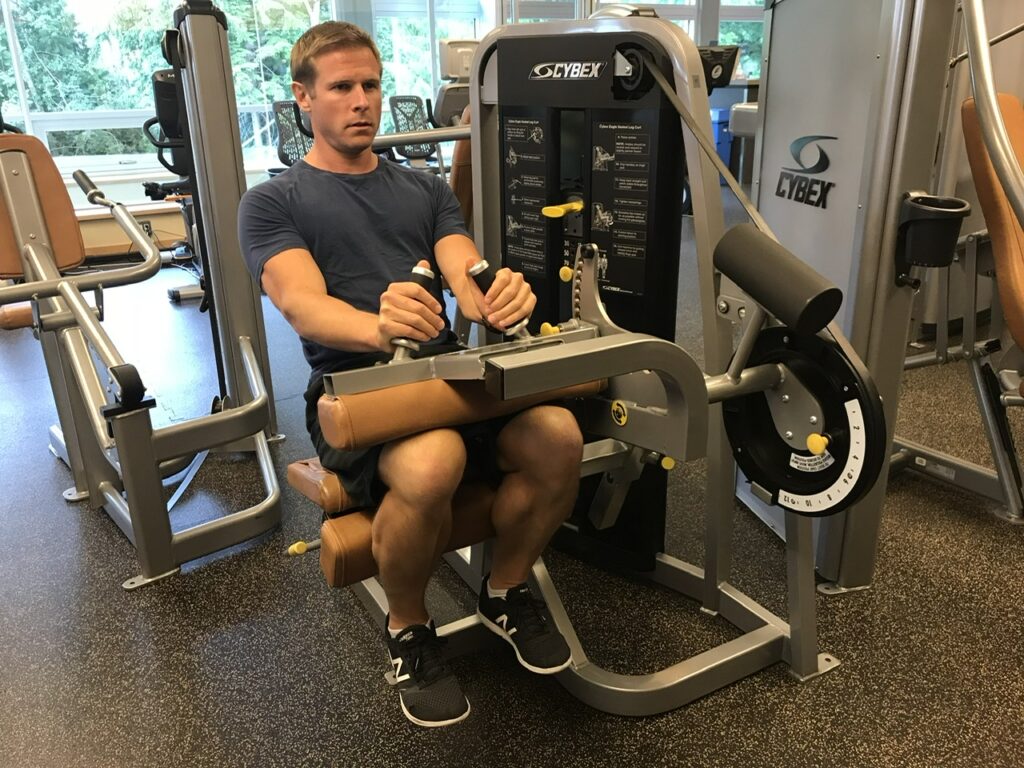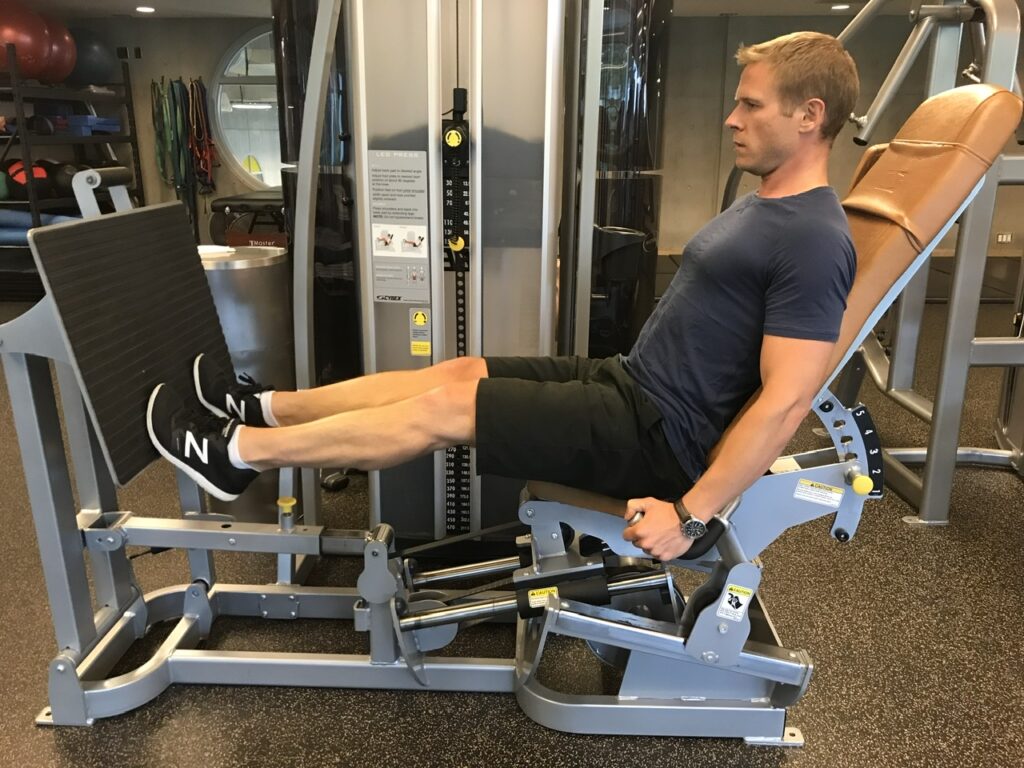In this post we discuss the best exercises for runner’s knee in the gym so you can get back to running again.

I’ll get straight to the point. If you’re a runner looking for things to do in the gym while you wait for your knee to get better, you can stop reading now.
This isn’t one of those articles about aqua jogging, or the elliptical machine, or even Alter G treadmills.
There are plenty of articles out there advising you how to maintain your cardiovascular fitness, or not get depressed whilst you’re injured. They are largely the reason I chose to write this.
Let me explain why.
Choosing to focus on these activities is rather like Tom Hanks in Castaway deciding to deepen his relationship with Wilson (the volleyball), rather than give the big luxury ocean liner a wave as it sails by.
The answer to your problem is likely in the same room, or at least the same building as the activity you’re trying to enjoy.
Why not focus your attention on getting back to the activity you actually enjoy?
Running.
That’s what you want to be able to do right?
Excellent. Let’s get to it.
To begin, let’s take a quick look at the demands of running and work back from there. Then it will be easy to see why the solution is staring us in the face.
The challenge of running
Running involves being able to tolerate forces equivalent to 2-3 times your body weight with every stride.
Even if you’re Mo Farah, that’s over 120kg every time your foot hits the ground.
Your body has an ingenious way of dealing with these forces. It’s called pronation.
Pronation is usually assessed at the foot, but it actually involves several joints. As soon as your foot hits the ground a sequence of events will occur at your foot, ankle, tibia, femur and even your trunk.
Think of it as your suspension system.
Many running injuries originate from a breakdown somewhere in this sequence.
If some of the muscles involved in pronation are unable to contract on demand, or their tolerance for force is low (they’re weak), then your ability to absorb force is compromised and those forces will begin to create issues.
Muscular contribution to running
Studies have shown the biggest contribution to running comes from your ankle plantarflexors (calves), over 50% in actual fact.
The second biggest contributor is your quadriceps (thigh muscles) with 30%.
So just those two muscle groups alone account for over 80% of the muscular effort that is required to run.
That gives us a pretty big clue where we should be focussing our efforts.
What about the glutes I hear you say? That’s what I’ve been working on!
The glutes are important not so much for their force output (their contribution sits at around 15% unless you’re a sprinter) but for something else, the alignment of your hip and therefore your knee as you run.
So taking all of that into consideration, let’s look at the exercises that are likely to get you back running as quickly as possible.
The best exercises for runner’s knee in the gym
First up we’re going to look at the muscles that attach directly around the knee.
Quadricep weakness
A recent study into the likely causes of PFPS found one of the key predictors of the condition was knee extensor weakness.
Of all the novice runners who participated in the study, it was those who had weak quadriceps at the start that went on to develop PFPS.
That’s a clear indication that strengthening your quadriceps may help.
And what’s the best way of doing that? The leg extension machine.
The leg extension machine

I’ve written before about this much maligned piece of gym equipment.
You may have heard it’s bad for your knees (not true) and that strength gained on this machine won’t transfer to life (bullshit).
The people who criticise it don’t understand force or motor learning. If your quadriceps need strengthening, there’s no better way to do it.
The two most important factors in using this machine are the set up and getting the challenge right.
How to set up the leg extension machine
- Make sure your knee is in line with the axis of the machine.
- Have the shin pad mid way up your shin.
- Keep your hips and knees in line.
- Ensure the machine isn’t able to take you into more knee flexion than you have available.
- Hold everything else perfectly still whilst performing the exercise.
Getting the challenge right
Getting the challenge right is a challenge in itself.
Firstly don’t think you have to move. Yes you read that correctly. Building strength doesn’t have to include movement.
If you’re experiencing issues around a joint, then the goal of any exercise is to maximise the stimulus to the muscular system, whilst reducing the stress to the joint.
Isometrics are again perfect for this. They can be used to great effect on machines like the leg extension.
My suggestion is this; carry out a very slow and light set on the leg extension. If you have no pain, excellent, you can move straight to the exercise itself.
If you do feel pain in your knee, make a note of exactly which part of the range the pain occurred.
Most leg extension machines will allow you to set the lever arm and therefore the shin pad anywhere within the range.
Set the machine at a point just before the painful sensation occurred.
Now take very gentle pushes into the shin pad at that part of the range. Aim for 6 x 6 second pushes at around 30% of your maximum effort.
This post will explain how to do this in more detail.
After a few sessions using the machine in this way, check back in and see if you find a difference.
If all is well use 1 set of 6-8 repetitions at the following speed.
5 seconds for the shortening phase (knee straightening)
1 second pause at the top of the movement
5 seconds for the lengthening phase (knee bending)
1 second pause without releasing the tension
The seated leg curl machine

Exercise number two in the gym is the seated leg curl.
If you have weakness on one side of the knee joint, you’re almost certain to have weakness on the other side.
Your central nervous system (CNS) will likely have been attempting to reduce the forces that your knee is exposed to.
Even if it hasn’t, you can’t go wrong getting your knee flexors stronger.
How to set up the seated leg curl machine
Similar to the leg extension, the leg curl must be set up correctly for best results. Here are the main points.
- Make sure your knee is in line with the axis of the machine.
- Have the pad set just below your calf muscles.
- Keep your hips and knees in line.
- Ensure the machine doesn’t take you into more knee extension than you have available.
- Sit tall on the machine and make sure you stay that way throughout. Use the handles to brace yourself.
Getting the challenge right
It is unlikely this machine will cause any pain. If it does use the same strategy I recommended for the leg extension.
Use 1 set of 6-8 repetitions at the following speed.
5 seconds for the shortening phase (knee bending)
1 second pause at the back of the movement
5 seconds for the lengthening phase (knee straightening)
1 second pause without releasing the tension
Calf raises
If over 50% of the muscular contribution to running comes from your ankle plantarflexors (calves) you’re going to get significant benefit from getting them stronger.
How do you do that? Calf raises.
How to set up calf raises
A common mistake with this exercise is to let your heels drop too far, especially if you’re using the edge of a step. To avoid this go from the floor to begin with.
Additionally, hold on to a wall for balance. The goal of this exercise is to get your calves stronger, not improve your balance. That will come as a consequence of having stronger calves.
Getting the challenge right
Start with your body weight and add resistance if you can easily complete 8 repetitions moving at the following slow repetition speed.
5 seconds for the shortening phase (heels lifting)
1 second pause at the top
5 seconds for the lengthening phase (heels coming down)
1 second pause without releasing the tension

The easiest way to increase the challenge is to perform them on a leg press machine. Maintain a slight bend in your knee and again make sure the machine doesn’t take you into passive dorsiflexion.
Focus on lifting your heel as far away from the platform as possible without lifting the 1st MTP joint (the joint your big toe connects to).
Summary
Resistance training, used correctly has the potential to help you recover from any injury. Runner’s knee is no exception.
Start cautiously and never work through pain. In time you’ll be a stronger, faster, injury free runner.